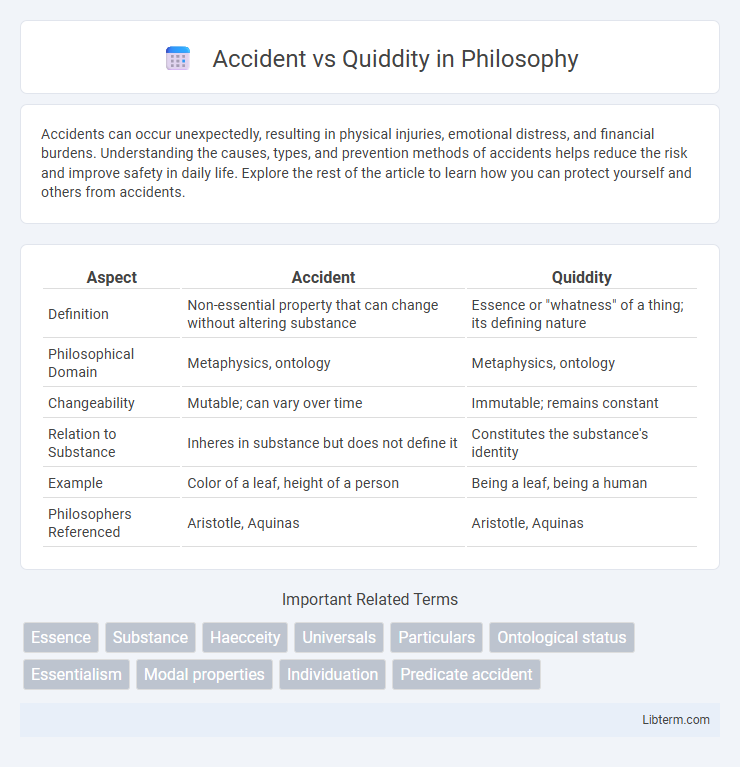Accidents can occur unexpectedly, resulting in physical injuries, emotional distress, and financial burdens. Understanding the causes, types, and prevention methods of accidents helps reduce the risk and improve safety in daily life. Explore the rest of the article to learn how you can protect yourself and others from accidents.
Table of Comparison
| Aspect | Accident | Quiddity |
|---|---|---|
| Definition | Non-essential property that can change without altering substance | Essence or "whatness" of a thing; its defining nature |
| Philosophical Domain | Metaphysics, ontology | Metaphysics, ontology |
| Changeability | Mutable; can vary over time | Immutable; remains constant |
| Relation to Substance | Inheres in substance but does not define it | Constitutes the substance's identity |
| Example | Color of a leaf, height of a person | Being a leaf, being a human |
| Philosophers Referenced | Aristotle, Aquinas | Aristotle, Aquinas |
Defining Accident and Quiddity: Key Philosophical Terms
Accident refers to properties or attributes that can change without altering the essence of a substance, such as color or size, whereas quiddity denotes the inherent nature or "whatness" that defines an entity's identity. Philosophers distinguish accident from quiddity to explore how objects maintain their core identity despite variations in accidental qualities. Understanding this distinction is crucial for metaphysical discussions on substance, identity, and change.
Historical Origins: Accident and Quiddity in Ancient Philosophy
Ancient Greek philosophers like Aristotle first distinguished accident and quiddity, where quiddity defines the essential nature of a substance, and accident refers to its non-essential, changeable properties. Aristotle's metaphysics identifies quiddity (the "whatness") as the substance's core essence, while accidents encompass attributes like color, size, or position that do not alter the substance's identity. This foundational distinction shaped medieval scholastic thought, influencing how later philosophers categorized reality into essence and non-essential characteristics.
Essential vs. Non-Essential Properties: Understanding the Distinction
Accident refers to non-essential properties that can change without altering the fundamental nature of an entity, while quiddity denotes the essential properties that define the entity's true essence. Understanding this distinction highlights that essential properties are necessary for an object's identity, whereas accidental properties are contingent and can vary. Philosophical discussions of substance and identity frequently emphasize the importance of quiddity in preserving the core being despite changes in accidental attributes.
Accident in Aristotle’s Metaphysics: What Is Non-Essential?
In Aristotle's *Metaphysics*, an accident is defined as a non-essential property that can change without altering the substance's fundamental nature, such as the color or position of an object. Accidents do not constitute the essence or quiddity of the substance, which remains constant regardless of these changes. Understanding accidents helps distinguish between what a thing is (its essence) and what it happens to be (its accidental properties).
Quiddity Explained: Unpacking ‘Whatness’ or Essence
Quiddity, rooted in classical ontology, refers to the intrinsic essence or 'whatness' that defines the identity of an entity, distinguishing it from accident, which comprises non-essential, variable attributes. This concept elucidates the core properties that remain constant despite changes in accidental qualities, providing a framework for understanding the unchanging nature of things. Philosophers use quiddity to explore the fundamental question of what a thing truly is, beyond its transient features.
Real-World Applications: Accident and Quiddity in Science
Accident and quiddity play crucial roles in scientific classification and experimentation, with quiddity representing the essential nature or defining properties of a substance, while accident refers to non-essential attributes that can vary without altering its identity. In chemistry, for example, water's quiddity is its molecular composition H2O, while accidents include temperature and state changes like ice or vapor. Understanding the distinction aids in precise experimental design and interpretation of results in disciplines such as biology, where species share a quiddity but exhibit accidental variations like color or size.
Accident and Quiddity in Medieval Scholastic Thought
In Medieval Scholastic thought, quiddity refers to the essential nature or "whatness" of a thing, defining its fundamental identity, while accident denotes a property that can change without altering the substance itself. Scholastics like Aquinas emphasized quiddity as the metaphysical core that determines a being's essence, distinguishing it from accidents which include qualities like color, shape, or position. This distinction underpinned debates on substance and change, highlighting how accidents affect appearance without affecting the underlying quiddity of an object.
The Role of Accident and Quiddity in Modern Metaphysics
Accident and quiddity play crucial roles in modern metaphysics by distinguishing between the essential nature of an entity and its non-essential attributes. Quiddity defines the intrinsic essence that makes a thing what it fundamentally is, while accident refers to properties that can change without altering the entity's core identity. Contemporary metaphysical discussions often explore how this distinction informs debates on identity, persistence, and the nature of properties in both concrete and abstract objects.
Comparing Accident and Quiddity: Core Differences Summarized
Accident refers to properties or attributes that can change without altering the essence of a subject, while quiddity denotes the inherent nature or essence that defines what a thing fundamentally is. Accidents are contingent and mutable features, such as color or shape, whereas quiddity embodies the permanent, essential characteristics that remain constant. Understanding the core difference highlights how accidents affect superficial aspects, whereas quiddity establishes the identity and essential reality of an entity.
The Continuing Relevance of Accident and Quiddity Today
Accident and quiddity remain crucial in contemporary philosophy for distinguishing essential properties of entities from their non-essential attributes. Modern metaphysics applies these concepts to debates in identity theory, ontology, and the philosophy of language, emphasizing the persistence and change of objects over time. Their relevance extends to artificial intelligence, where understanding essential versus accidental features aids in knowledge representation and reasoning systems.
Accident Infographic

 libterm.com
libterm.com